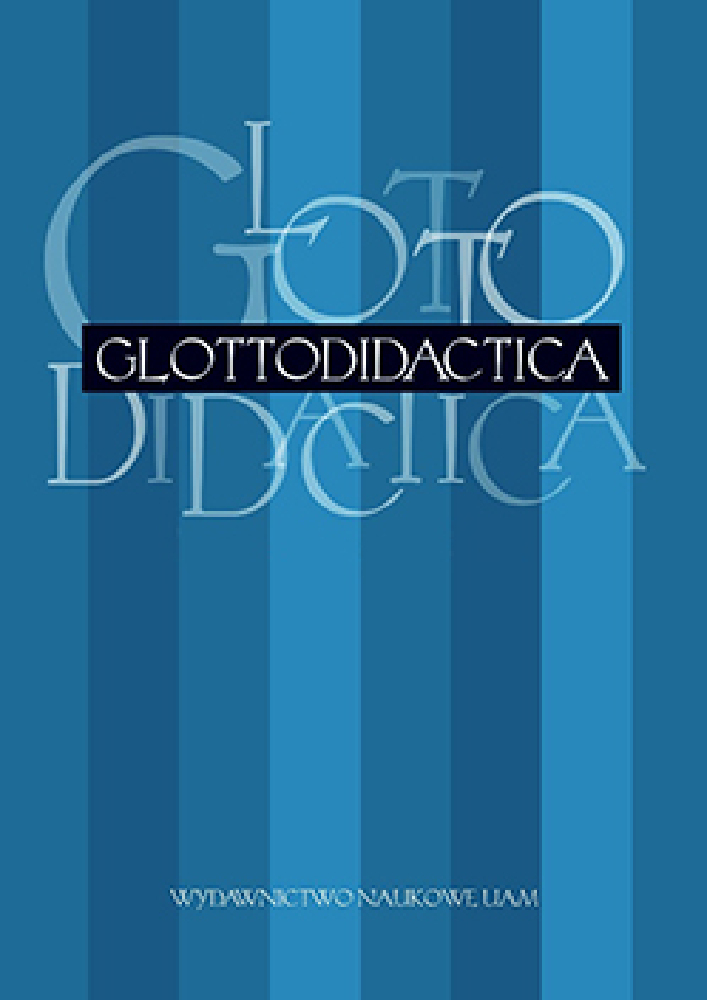Abstract
The paper analyses sample drawings produced by blind children. The focus will be put on the representation of concepts. Major findings gathered in the discussion section show that sight plays complementary rather than primary role in the process of conceptual development, which supports other research in the field of blindness studies conducted so far.References
Bussmann, H., Gregory, T., Kazzazi, K., 1996. Routledge dictionary of language and linguistics. London–New York: Routledge.
Cratty, B., Sams, T., 1968. The body-image of blind children. New York: American Foundation for the Blind.
Cutsforth, T., 1932. The unreality of words to the blind. In: Teachers Forum 4, 86-89.
DeMott, R., 1972. Verbalism and affective meaning for blind, severely visually impaired, and normally sighted children. In: New Outlook for the Blind 66 (1), 1-8.
Dokecki, P., 1966. Verbalism and the blind. A critical review of the concept and the literature. In: Exceptional Children 32, 525-530.
Dromi, E., 1999. Early lexical development. In: Barrett, M. (ed.). The development of language. Hove–New York: Psychology Press, 99-126.
Dunlea, A., 1989. Vision and the emergence of meaning. Blind and sighted children’s early language. Cambridge: Cambridge University Press.
Gleitman, L., 1990. The structural sources of verb meaning. In: Language Acquisition 1, 3-55.
Heller, M.A., 2002. Tactile picture perception in sighted and blind people. In: Behavioral Brain Research 135, 65-68.
Kennedy, J., 1993., Drawing and the blind. New Haven–London: Yale University Press.
Klimasiński, K., 1989. Organizacja czynności poznawczych przy głębokim defekcie wzroku. Kraków: Wydawnictwo Uniwersytetu Jagiellońskiego.
Landau, B., 1983. Blind children’s language is not meaningless. In: Mills, A.E. (ed.). Language acquisition in the blind child: normal and deficient. London: Croom Helm, 62-76.
Landau, B., Gleitman, L., 1985. Language and experience. Evidence from the blind child. Cambridge, Massachusetts–London: Harvard University Press.
McLinden, M., McCall, S., 2002. Learning through touch. Supporting children with visual impairment and additional difficulties. London: David Fulton Publishers.
Majewski, T., 1983. Psychologia niewidomych i niedowidzących. Warszawa: Państwowe Wydawnictwo Naukowe.
Margolis, E., Laurence, S., 2006. Concepts. In: Brown, K. (ed.). Encyclopaedia of language and linguistics. Elsevier Science, 817-820.
Millar, S., 1994. Understanding and representing space. Oxford: Oxford University Press.
Perez-Pereira, M., Conti-Ramsden, G., 1999. Language development and social interaction in blind children. Hove–New York: Psychology Press.
Recchia, S., 1997. Play and concept development in infants and young children with severe visual impairments: a constructivist view. In: Journal of Visual Impairment and Blindness, 91, 401-406.
Rosel, J.A., Caballer, P.J., Olivier, J.C., 2005. Verbalism in the narrative language of children who are blind and sighted. In: Journal of Visual Impairment and Blindness, 413-425.
Sękowska, Z., 1974. Kształcenie dzieci niewidomych. Warszawa: Polskie Wydawnictwo Naukowe.
Szczechowicz, A., 1976. Swoistość kształtowania się pojęć u dzieci niewidomych. In: Klimasiński, K. (ed.). Procesy poznawcze a defekty sensoryczne. Materiały I Krajowego Sympozjum Psychologii Defektologicznej. Warszawa: Instytut Psychologii, 86-99.
License
Authors
Authors of texts accepted for publication in Glottodidactica are required to complete, sign and return to the Editorial team’s office the Agreement for granting a royalty-free license to works with a commitment to grant a CC sub-license.
Under the agreement, the authors of the texts published in Glottodidactica grant Adam Mickiewicz University in Poznań a non-exclusive, royalty-free license and authorize the use of Attribution-NoDerivatives 4.0 International (CC BY-ND 4.0) Creative Commons sub-license.
The authors retain the right to the free disposal of the work.
Users
Interested Internet users are entitled to use works that have been published in Glottodidactica since 2016, under the following conditions:
▪ attribution – obligation to provide, together with the distributed work, information about the authorship, title, source (link to the original work, DOI) and the license itself.
▪ no derivatives – the work must be preserved in its original form. Without the author's consent, it is not possible to distribute the modified work in the form of translations, publications, etc.
Copyrights are reserved for all texts published before 2016.
Miscellaneous
Adam Mickiewicz University in Poznań retains the property right as a whole (layout, graphic form, title, cover design, logo etc.).
Privacy statement
The names and email addresses published on this journal site will be used exclusively for the purposes declared by this journal and cannot be used for any other purpose or by any other party.




